While there are moments where it is adorable to hear our little ones say “wabbit” when talking about bunnies, “lello” when talking about the color of the sun, or even seeing their tongue pop out when hissing like a snake, these are all signs that they may need speech therapy.
Types of Speech Sound Disorders
Typically, speech sound disorders are thought of as “R” an “S” sounds. However, speech sound disorders is am umbrella term refer to many different types of speech deficits that children can have. Three of the main categories of speech sound disorders are Childhood Apraxia of Speech (CAS), Phonological Processes and Articulation Errors.
Typically, speech sound disorders are characterized by a deletion of a sound from a word, addition of a sound to a word, substitution of one sound for another, or distortion of a speech sound. The focus of this blog post, articulation disorders, are most commonly a sound substitution (example: substituting “UH” for ‘R’ like"guh-l" for ‘girl’) or a sound distortion (example: an “S” that sounds slushy). Some speech sound irregularities are expected as our little ones grow and develop, but if they persist, your child may need further intervention.
(Of note, speech sound disorders can include a multitude of other characteristics, not just the brief description given above.)
Articulation Disorders
Articulation Disorders are articulatory errors that are typically related to misplacing our tongue, lips, or other articulators resulting in a sound substitution or a sound distortion. As our little ones grow, they begin to develop speech sounds in a developmental order. Depending on your child’s age, their articulatory errors may be typical and expected. Below you’ll find the typical age we can expect little ones to begin saying certain sounds and examples:

Looking Beyond Speech Milestones
While the above developmental norms are important when considering if a child may benefit from speech therapy, there a multitude of other variables that should also be considered as well:
- Family history: A family history of speech or learning difficulties is important to be aware of. While this is by no means a determinant of your child’s abilities, they may benefit from earlier intervention rather than the “wait and see” approach.
- Presence of phonological processes: As mentioned earlier, phonological processes are a type of speech sound disorder. They are patterns of sound errors that initially help simplify speech for our little ones. Similar to the above articulation milestones, there is a developmental hierarchy in which we can expect to see children grow out of these patterns. Phonological processes that persist past their expected age may be indicative that a child would benefit from speech therapy sooner rather than later.
- Intelligibility: This is the percentage that a child is understood by others. We want 3 year olds to be 75% intelligible and 4 year olds to be 100% intelligible by unfamiliar listeners. If your child is very unintelligible, regardless of what sounds they have, they may benefit from speech services.
- Difficulty learning to read and write: Children with speech sound disorders are at a higher risk of literacy-related delays
- Social and emotional impact: If your child is particularly aware and self-conscious of their speech errors, it may impact their social engagement with their peers at school and extracurricular activities.
How intelligible should my child be?
As mentioned above, intelligibility is a percentage of which a child is understood by both familiar and unfamiliar listeners.
So often, we find that parents are personal translators for their little ones. A child may say “Ah ee uh aabih” and their mom, dad, or caretaker will casually tell their teacher or friend “Oh, they said that they see a rabbit.” Because your little one spends more time interacting and communicating with you, you may have an easier time understanding him or her than others may.
As you’ll see below, children become about 25% more intelligible each year that they grow starting with 2 year olds being about 50% intelligible, working up to 4 year olds and above to being approximately 100% intelligible. It is important to note that these percentages apply to familiar listeners. Familiar listeners can include: caretakers, siblings, babysitters, and any adults who live in the home with the child.

While it is extremely important that our children feel understood by their parents and caretakers, we also want our children to feel heard and understood by unfamiliar listeners. Unfamiliar listeners can include your child’s classmates and teachers, but also a waiter at a restaurant, a substitute teacher, or even family visiting from out of town.
In the following chart, you’ll find the expected percent of intelligibility for children with unfamiliar listeners.

If you find yourself thinking “I can’t understand my child” or that you understand them perfectly well, but your child’s speech is hard to understand for others, they may benefit from speech therapy… even if the sounds they have difficulty with aren’t expected at their current age.
What if my child can’t say his name?
A final consideration to make note of when thinking of articulation disorders is our child’s name and other important words in his or her life. Even if your child isn’t expected to say a specific sound until a certain age, if it is greatly impacting their ability to say their name, family members, or even favorite food, it is impacting their daily communication.
As mentioned throughout this post, we consider variables beyond developmental norms when considering if a child would benefit from speech therapy. If a child is unable to say their name or other important words, they may be less intelligible to others (see above), but also may begin to develop a negative self-perception. At MollyBSLP, we don’t believe in the “wait and see” approach, we feel that if your child is feeling frustrated with his or her speech or if you, their caregiver, feel stressed or concerned about their development, it is best to reach out to a professional for support and guidance.
How do I get my child into speech therapy?
At MollyBSLP, we offer virtual speech therapy in NY, and VA. Do you have concerns about your child’s speech development?
References
- Crowe, K., & McLeod, S. (2020). Children’s English consonant acquisition in the United States: A review. American Journal of Speech-Language Pathology.
- Hustad, K. C., Mahr, T. J., Soriano, J. U., & Rathouz, P. J. (2021). Speech Development Between 30 and 119 Months in Typical Children II: Articulation Rate Growth Curves. Journal of Speech, Language, and Hearing Research, 64(11).